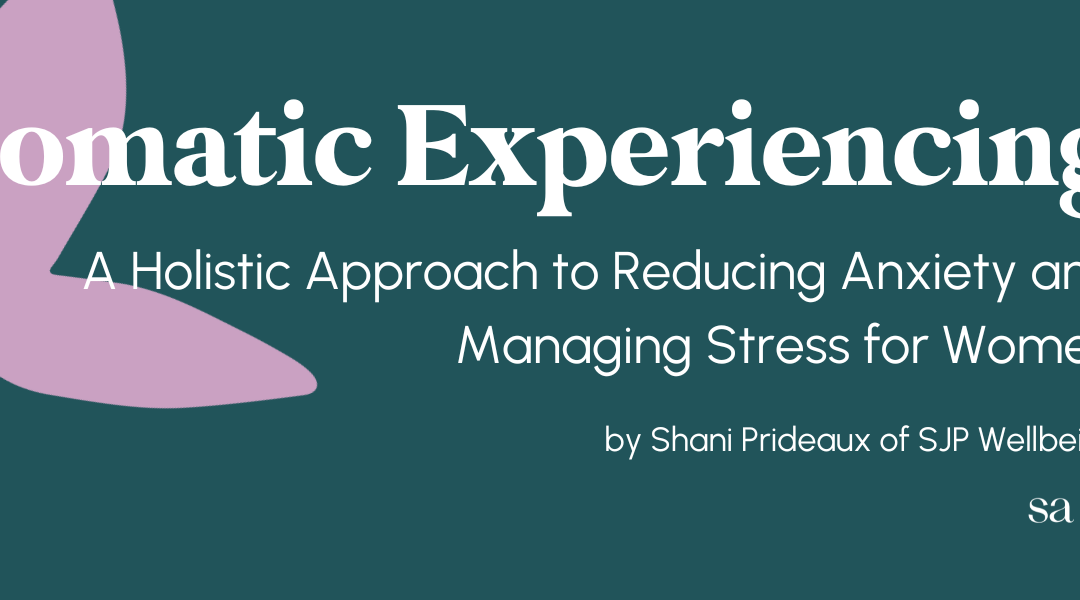As women, we are often wearing multiple hats. We might be juggling work, being a mum, social commitments and trying to drink water! With so much on our plates, it’s no surprise that stress and anxiety can take a toll on our mental and physical well-being.
If you’re struggling to manage the mental load, feeling anxious or stressed, it might be time to try a new approach (The to-do lists only work for a while). So if you haven’t actioned this thing called self-care yet, because you’re legit too busy and it’s just another thing getting lower on the priority scale, I’m going to attempt to make it one and introduce you to somatic and vagus nerve work.
So firstly, what exactly is stress, what is overwhelm and what is anxiety?
Stress, anxiety, and overwhelm are all functions of the brain and body that play a vital role in our survival and ability to cope with challenges. When we experience a stressful or overwhelming situation, our brain activates the hypothalamic-pituitary-adrenal (HPA) axis, triggering the release of stress hormones like cortisol and adrenaline. These hormones increase heart rate, blood pressure, and breathing rate, preparing the body for a “fight or flight” response. It motivates us to act and we want it to work well. Like, when you have to jump out the way of a moving car, you want your body reactive. This is helpful info for many so that we can try to reframe our perception of our bodies and brains working for us and not against us.

While this response is necessary and even helpful, chronic stress and anxiety can have negative effects on our health, It’s designed for short burst- appropriate response, like the car. Chronic stress increases the risk for cardiovascular disease, weakens our immune system, and creates or worsens pre-existing mental health problems, and feels horrible.
Ongoing stress, anxiety and mental load can all lead to overwhelm, or even burn out, which is the feeling of being unable to cope with the demands placed on us. This can result in fatigue, difficulty concentrating, and a sense of hopelessness. Contrary to popular belief, the answer to overwhelm is not a list, or increased productivity. The above explained stress response once at overwhelm, means system shut down, affectionately referred to as ‘going dorsal’ which speaks to the dorsal response, whereby we cannot get our brains to switch on, we may disassociate, or go offline in a multitude of ways, even fainting. The only antidote to true overwhelm is to stop and allow the nervous system to reset.
It is important to practice stress-management techniques, such as mindfulness and exercise, to help regulate our stress response and maintain our overall health. So let’s talk about how somatic experiencing fits in.
What is Somatic Experiencing?
Somatic experiencing is a therapeutic method that focuses on the connection between the mind and body. It was developed by Dr. Peter Levine, a psychologist and trauma expert who believes that unresolved trauma can manifest as physical and emotional symptoms, including anxiety, stress, and chronic pain, but you don’t need to have experienced significant trauma to benefit from this work.

The goal of somatic experiencing is to help individuals “reset” their nervous system, allowing them to process and release the energy associated with traumatic experiences. You can think of the body as having a big funnel attached to the top, and all of the daily ‘stressors’ drip, or even pour in. In this instance we can view the build-up of those stressors as being traumatic for the nervous system. Somatic reset can be done through a series of exercises and techniques that focus on body sensations, emotions, and memories.
Here are some of the ways that somatic experiencing can benefit us:
Calming the Mind and Body: Our central nervous system is regulated by the ability to heal and rest after a stressful period, but have you ever tried to rest when you’re not feeling calm? Many clients tell me that they leave feeling worse and more stressed, because they can’t relax, I resonate. Somatic experiencing helps individuals become more aware of their body sensations and attached emotions. By paying attention to these sensations, we can learn to regulate our nervous system and calm the mind and body.
Reducing the Impact of Trauma: People who have experienced trauma may find that somatic experiencing helps them process and release the energy associated with traumatic memories. This can reduce the impact that trauma has on their mental and physical health. If this is you, and you haven’t read ‘The Body Keeps The Score, by Besser Van Der Kulk, I’d highly recommend it. Our bodies hold so much.
Improving Self-Awareness: Somatic experiencing encourages individuals to become more present in the moment. This can help us to identify the build-up of stress and anxiety before it’s taken over and develop coping strategies to manage it.
Increased Emotional Resilience: By learning to regulate the nervous system and manage stress and anxiety, we can improve our emotional resilience. Emotional resilience isn’t ‘toughness’, I like to describe it as ‘emotional agility’ whereby we can go through experience’s, all the while knowing that it’s not a fixed state, and we can help ourselves move through it. This can help us better cope with life’s challenges and bounce back from setbacks.
Easy ways to implement somatic experiencing regularly in your day to day life:
Cold exposure: Many people are on the band wagon of ice baths, but I doubt I ever will, yuck. The benefits of cold exposure are in part due to vagus nerve activation. The vagus nerve is in charge of our digestion, heart rate and breathing rate, among other things and benefits from regulation in times of anxiousness. So if ice baths aren’t for you either, try placing cold water or ice on the wrists, neck and forehead. Even just a few minutes helps to regulate our nervous system.
Singing: The vagus nerve is responsible for swallowing and other internal organs. We can gain a great deal of benefit from working the muscles involved in the back of the throat, including the vocal chords. Singing, humming and gargling can be very therapeutic. So can a big loud sigh, or coughing.
Muscle activation and pressure: Along with vagus nerve regulation, a bunch of helpful hormones are released when we squeeze our muscles. Weight/resistance training has this in spades. It can also be helpful to practice progressive muscle relation, whereby you would consciously squeeze a muscle group as hard as you can, and then release it, then move on to another body part. Alternatively a strong hug (even hugging yourself), massage, and weighted blankets can help.
Body scan: Take a moment to close your eyes, take some deep breaths and internally scan over your body starting at the top of your head. As you notice tension, pain, or feelings of some kind, visualise breathing into that space and releasing the tension, and or move that part of the body to release it, such as a shoulder roll, or stretching your jaw by opening your mouth wide.
The big exhale: Imagine your stomach is like a sponge, when you take a big breath in to the belly expand out as much as you can, hold it for a few seconds and then squeeze the sponge as hard and fast as you can, squeezing your belly in to your spine and exhaling the air out of your mouth with force. This is another great way to activate the vagus nerve and release tension, repeat as many times as you need.
Chewing: Chewing also works the muscles in the throat and helps the vagus nerve, so you could chew gum. Or, you could utilise this as a mindfulness practice. Think about your food as a sensory experience, aim to remove distraction as much as possible and focus your awareness to what you see, hear, smell, taste and feel. Pay attention to the sensations and the texture, chew slowly and purposefully.
About Shani Prideaux

Shani is a degree qualified counsellor with a background in positive psychology and wellbeing and utilises mindfulness, breathwork and other somatic/emotion focussed modalities in her therapeutic client work. Shani has worked extensively with young people and their families in foster networks, via NDIS, in schools residential rehab and more.
Shani has a special interest in addiction, body image and self-image issues, anxiety and stress management and grief and trauma.
Website: www.sjpwellbeing.com
Facebook: SJP Wellbeing
Instagram: @sjp_wellbeing_
To become an SA Woman Member, check out our Membership Options here.

